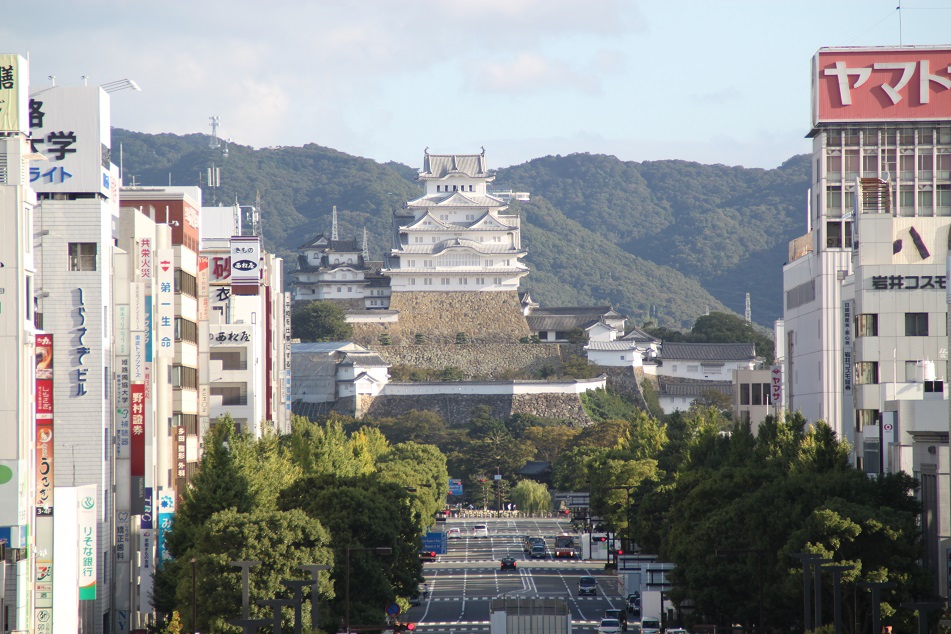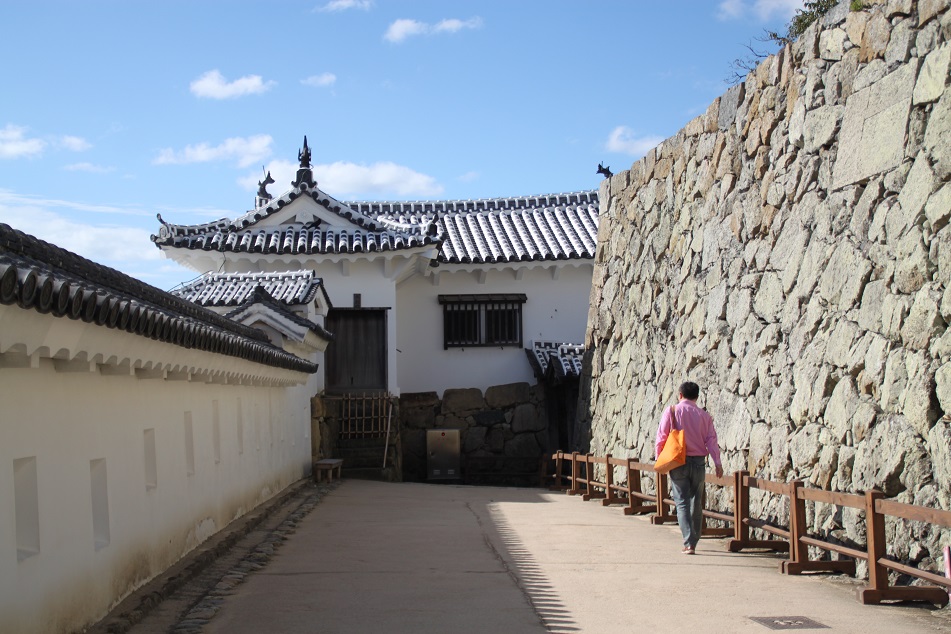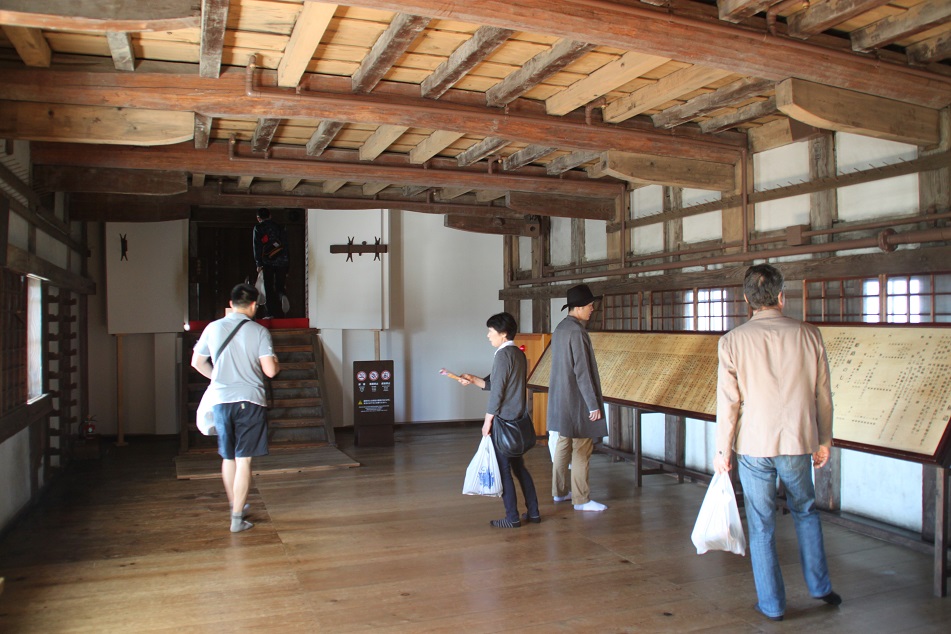In Ancient Egypt, the heron was believed to be the creator of light, while the double-headed heron symbolized prosperity. Halfway across the world in Ancient China, the bird was regarded as a symbol of strength, purity, patience and long life. However in Japan, an egret – a species of heron distinguished by its white plume – can take the shape of a flightless giant.
One morning at the start of the Japanese autumn, James and I take a Shinkansen bullet train with its distinctive beak-shaped nose from Okayama to Himeji, a city of 535,000 people in Central Japan. As soon as we get off the train, the egret welcomes us and every other passenger from the end of a boulevard that stretches from the train station. Perched on a hill overlooking the city’s rows of concrete buildings, Himeji Castle, affectionately known as the “Castle of the White Egret” or “White Heron Castle” for its bright white exterior, was inscribed as one of Japan’s first UNESCO World Heritage Sites in 1993. The imposing castle seems to grow even more impressive as we walk closer down the wide boulevard.
In the Orient a heron has become a symbol of strength and long life for generations, and the White Heron Castle’s long history perfectly epitomizes this notion. Constructed on the site of a 14th-century fortress, much of Himeji Castle’s current form dates back to 1609, a period of time when Japan was ruled by feudal military leaders known as shoguns. In the years that followed, several structures were added, eventually making the castle compound the largest in the country. Its glory days, however, ended when a prince called Mutsuhito ascended the Chrysanthemum Throne and became Emperor Meiji. He ushered in a new era for Japan by reclaiming full control of the country from the shoguns, effectively restoring the power of the Japanese emperor. After imposing a self-isolation policy for centuries, Japan experienced sweeping reforms encompassing politics, the economy and the military which led to the country’s rise as a regional power in the early 20th century.
Deemed as a burden from the past amid the rush for modernity, many Japanese castles were demolished under the new emperor’s order. With parts of its structures already turned into military barracks, a plan was underway to dismantle Himeji Castle, until a colonel by the name of Nakamura Shigeto successfully convinced the government to spare the landmark. Then came a local resident who purchased the expansive compound, for less than US$2,300 in today’s value, to develop the land. But soon he realized the cost would be too much to bear, and Himeji Castle was once again spared from destruction, until 1945.
In the final months of World War II, Himeji, along with other cities across Japan, was heavily bombed by the Allies. The air raids on Tokyo, Nagoya, Osaka and Kobe, among other places, not only decimated important Japanese factories, but also claimed the lives of hundreds of thousands of people and destroyed many castles, temples, and all sorts of heritage sites in the country. During the raid on Himeji, a bomb was dropped onto the castle and fell on its top floor. However, as if by divine intervention, it failed to explode, sparing the centuries-old magnificent structure from the same fate suffered by its surroundings.
Half a century later, a massive earthquake shook Kobe and rattled many buildings and roads in the city, roughly 50 km away from Himeji. The 6.9-magnitude quake also caused damage to the latter, but again, protection from the above seemed to keep the White Heron Castle safe. In 2010 the castle underwent a much-needed five-year restoration project aimed at bringing its bright white brilliance back after being exposed to the elements and soot for many years.
Fast forward to this autumn morning, and the castle staff members are handing out tickets to people who have already lined up at the gates, including us. Due to its popularity, a cap on visitor numbers is imposed to allow for a sustainable stream of tourists without putting too much pressure on the castle’s structural integrity. As we walk through Hishinomon, the first of the castle’s many gates, it becomes more obvious why Himeji Castle is one of a kind. We follow the labyrinthine pathways, through a series of smaller gates, to finally reach the main keep, a marvelous 46.4-meter white edifice whose multiple roofs resemble the flapping wings of an egret.
Inside the main keep, we climb through one wooden chamber after another, each bearing very little decorations but many secret hiding places. From the strong walls around the castle to hidden defensive mechanisms inside the main keep, everything was designed to thwart any unwanted visitors. When no engineering feat could mitigate a particular threat, they turned to age-old tradition and belief. In Japan, shachi – a mythical animal with the head of a tiger and the body of a carp – is believed to protect wooden structures from fire. Therefore its statues can be found on the roofs of Japanese castles, including the White Heron Castle, adding an artistic, whimsical touch to the structures’ exterior. The four-centuries-old Himeji Castle has endured the menace of abandonment, war, and earth’s powerful wrath, but its survival for many generations to come seems to depend even more on human goodwill.

















Japan’s rise as an industrial superpower without losing its heritage and culture is commendable and inspiring. In fact I remember reading your post about Kyoto which shows how modern technology was used as an aid to preserve ancient monuments.
LikeLiked by 1 person
Luckily there were people like Nakamura Shigeto who saw the importance of saving those cultural heritage for future generations, and Henry Stimson who urged President Truman to remove Kyoto from the list of air raid target. Thanks for reading, Sreejith!
LikeLike
beautiful post…. the place is beautiful and you lovely pictures do perfect justice with the place…..
LikeLike
Really appreciate your kind words, Sudhir! Himeji Castle is so beautiful and magnificent it looks even more imposing in person.
LikeLiked by 1 person
the world is filled with so much beauty….. i really wonder how much I will be able to admire in this life……
LikeLike
I often have the same thought. But as much as we want to see as many places as possible, we should never forget to enjoy every single journey we make. 🙂
LikeLiked by 1 person
cant agree more with you….. we should enjoy everything and every moment …. the culture….. food…..people……
LikeLiked by 1 person
How can governments decide to eradicate their own part of history by demolishing heritage structures? Loved your post and information, as always!
LikeLike
I guess the mood back then was to erase the vestiges of the shoguns just like how some people in eastern Europe deliberately leave many Communist monuments in decay. But I believe educating people about what went wrong in history and how we should move forward together is far more important and meaningful than being oblivious about the past altogether. Thanks for reading and sharing your thoughts!
LikeLiked by 1 person
Certainly, these are reminders of the errors of the past. Accept and move on.
LikeLiked by 1 person
Setiap prefektur punya kastil yg ikonik ya Bam. Suka dengan warna kastil Himeji ini. Kesannya elegan gitu. Waktu ke Jepang saya cuman kunjungj Kastil Osaka saja..
LikeLike
For some reason komenmu ini tadi nyasar ke Spam. Untung saya cek dulu satu-satu sebelum bersih-bersih folder Spam.
Betul, gaya arsitektur dan warna kastil di Jepang serupa tapi tak sama. Kastil Himeji terkenal dengan ukurannya yang besar dan warnanya yang putih, Kastil Osaka terkenal dengan hiasan emasnya, Kastil Okayama terkenal dengan warna gelapnya. Yang saya pengen banget lihat itu Kastil Matsumoto. Sepertinya indah banget.
LikeLiked by 1 person
Aduh kok komen-komen ku nyasar ke spam ya, bukan cuma di blog ini lo bam…
LikeLike
Hmm, kok aneh ya. Tapi dengan kamu di-unspam sama banyak orang semoga ke depannya setiap kamu komen gak otomatis terdeteksi sebagai spam sih.
LikeLiked by 1 person
Mudah-mudahan 🙂
LikeLike
wah, baru tahu ada Kastil Himeji ini, ternyata masih banyak kota di Jepang yang belum didengar namanya.
dan melihat sekilas Kastil Himeji ini amat mirip Kastil Osaka, bedanya yang di Osaka lebih glamor dan berwarna dengan ornamen emas.
dan terima kasih ceritanya, seru banget! 🙂
LikeLike
Saya juga sebenernya agak heran Kastil Himeji ini kurang dikenal sama banyak orang Indonesia, padahal berbeda dengan beberapa kastil lainnya yang lebih populer, Kastil Himeji ini struktur bangunannya masih asli. Saya pun baru tau mengenai kastil ini beberapa tahun yang lalu sih. Kastil Osaka meskipun ukurannya lebih kecil dibandingkan Kastil Himeji, tapi memang lebih “wah” karena ada ornamen emasnya. Konon sang empu yang membangun kastil ini memang sengaja menambahkan ornamen emas untuk pamer kekayaan. 🙂
Terima kasih sudah menyempatkan membaca, Yuki!
LikeLike
Impressive! How lucky that it’s survived. I recently read a book, Daughters of the Samurai which was about wanting to modernize Japan. It sounds boring, but I loved every page. If you’re interested, here’s my write up (as I also have a blog on books and writing):
https://readandwrite.blog/2017/08/06/janice-p-nimuras-daughters-of-the-samurai/
LikeLike
Three times it was so close to demolition, yet 400 years since its completion the castle still stands proudly on a hill. You know, actually the book doesn’t sound boring at all because many generations later a lot of people still face the same problem: those sent by their parents to study abroad then return only to feel disconnected with their home country. Thanks for the recommendation, Mallee!
LikeLiked by 1 person
You should visit the castle’s evil twin, the black crow castle in Matsumoto. It’s in one of my blogs.
LikeLike
Edwin, it was in fact your photos of Matsumoto Castle that made me want to go there even more — I think I also left a comment on that particular post of yours. So many beautiful and magnificent castles to explore!
LikeLiked by 1 person
Beautiful places and incredible buildings.
LikeLike
I haven’t seen all castles in Japan, but I can confidently say that Himeji Castle must be one of the most impressive centuries-old castles in the country. Thanks for dropping by, Caroline!
LikeLiked by 1 person
Bama, I have to say that Himeji Castle was just as magnificent as I’d remembered from my first trip there more than 15 years ago. But I did notice one clear difference after the long renovation; even the roof tiles shone a dazzling white in the morning sun. Your photos bring back some fond memories and they make me wonder if we should have stayed overnight in Himeji (to explore a bit further and see the castle by night).
LikeLike
I remember your photo of Himeji Castle during the cherry blossom season, and it’s probably among the first images of the castle that piqued my interest of the Japanese architectural marvel. The five-year renovation clearly paid off as the castle was so bright and impressive as we walked closer to the main keep. Such a magnificent structure it really is! I vaguely remember reading about some smaller shrines in the vicinity, so maybe one day when we return we can check them out.
LikeLiked by 1 person
From a military point of view the bombing raids on Japan and Germany during the closing months of WW2 made no sense. In many cases these were civilian targets, where many innocent people lost their lives. Your photography again presents stunning images of the many amazing buildings in Japan. Well done, Bma!
LikeLike
Sadly today many civilians in war-torn places around the world are still facing a similar situation. Many countries have learned from their dark past, but unfortunately some others have to go through the atrocities themselves before seeing better days. Thanks for your thoughtful words, Peter! And thanks for reading.
LikeLiked by 1 person
I absolutely love the look of this castle – the pure white against the stone is visually arresting and so different from the fussiness of many temples. You two are constantly adding to my burgeoning list of places to see in Asia!
LikeLike
Truly Japanese aesthetics at its best! As much as I love intricate stone or wood carving, I find pure beauty and elegance in Japanese simplicity. I can’t wait to go back to Japan and explore more of its architectural wonders, among other things. But then I have a feeling your stories from Central Europe will distract me to an extent I have yet to know. 🙂
LikeLiked by 1 person
I love Himeji Castle, it is so beautiful. I also really liked that when we walked inside a Japanese guy just came up to us and offered us a free tour, he wouldn’t accept any money for it he just wanted to share the history of the place with us. That is part of what makes Japan so amazing, they have such a wonderful National pride.
http://www.mytravelbugbite.com
LikeLike
In many countries that I’ve been, when a guy just comes up like that I will be extra-cautious for whatever scam he’s about to sell me. But I’m not at all surprised that was not the case with you because Japan is just so special. I feel like they have a collective identity which is built upon respect for others and being considerate to fellow humans, among other things. Thanks for sharing your lovely experience, Emma!
LikeLiked by 1 person
What an extraordinary architectural accomplishment. I can only imagine how impressive it is standing in front of it. The bullet train looks like the way to travel!
LikeLike
As is the case with other magnificent monuments around the globe, pictures don’t do them justice. Himeji Castle was so imposing I felt really small standing in front of the main keep. Japanese bullet train surely has one of the most attractive appearances compared to other high-speed train in the world. Thanks for reading, Sue!
LikeLiked by 1 person
Your pictures and the way you tell the story are just amazingly beautiful. That makes me want to go there!
LikeLike
Merci Nicolas! I’m really glad you enjoyed this post. When you do visit Himeji Castle one day, hopefully the restoration work will be completely done so you can marvel at every nook and cranny of this impressive structure.
LikeLike
Couldn’t help drawing parallels with Brussels and their urban renewal sprees Bama. The early 19th century seems to have been an era of demolition – destruction in my book! – across the world. Remarkable how this castle survived every calamity. Has got to be a sign from the universe 🙂 Just realised how much whiter the Himeji is compared to the Osaka castle. Wonder if that is also associated with a bird?
LikeLike
I wasn’t aware of the extent of Brussels’ urban renewal until I read your post, Madhu. Back then, tearing down the old and building things anew seemed to be the trend — which unfortunately still is in some parts of Asia. I’ve never heard of any association of Osaka Castle with a bird, or any kind of animal, although I won’t be completely surprised if there is. Probably some flamboyant animal who loves to flaunt her beauty? 🙂
LikeLike
Your opening shot is incredible, it shows a blend of the modern with the past, but with the past definitely taking the front row seat. I am always impressed by those who are able to move forward and succeed and doing so without losing its history or culture. Wonderful post in showing how both past and present can (and need to) be infused.
LikeLiked by 1 person
Thanks Randall! Blending the modern with the past is what the Japanese are really good at. Some people tend to forget or erase the past to move forward, leaving invaluable heritage sites crumbling in many places around the world. But Japan shows the way how cultural preservation can go hand in hand with development.
LikeLike
Pingback: Kurashiki: A Glimpse of Pre-War Japan | What an Amazing World!
It’s unbelievable that anyone would even consider tearing down this spectacular castle. I especially like the next to the last photo that shows more sections of the building. The slightly curved roof lines add so much grace. Wonderful!
LikeLike
Unfortunately back then heritage building preservation was really not in most people’s minds, as was the case with a lot of ancient Hindu/Buddhist temples in Indonesia. But I can see how education is gradually changing people’s perspective about it. To be honest wherever you see it from, Himeji Castle would always look magnificent. It’s one of the most impressive monuments from the past I have seen in my life.
LikeLike
Pingback: Nijo-jo: From the Hollyhock to the Chrysanthemum | What an Amazing World!